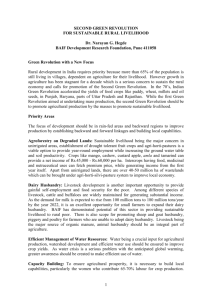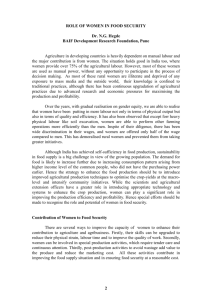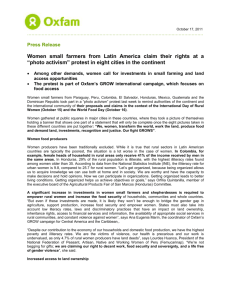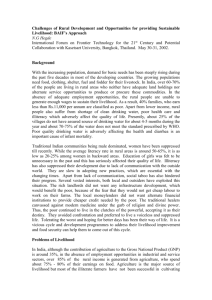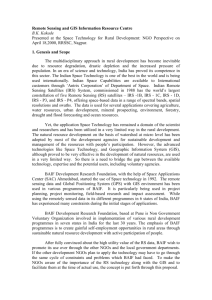Technologies for providing Sustainable Rural Livelihood
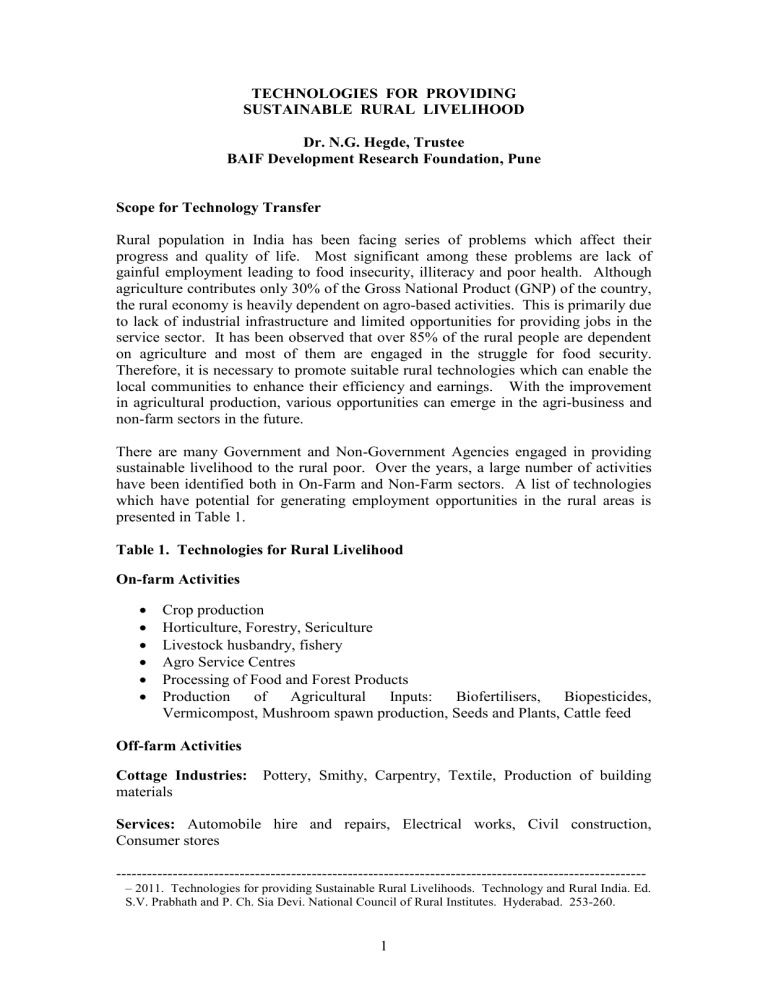
TECHNOLOGIES FOR PROVIDING
SUSTAINABLE RURAL LIVELIHOOD
Dr. N.G. Hegde, Trustee
BAIF Development Research Foundation, Pune
Scope for Technology Transfer
Rural population in India has been facing series of problems which affect their progress and quality of life. Most significant among these problems are lack of gainful employment leading to food insecurity, illiteracy and poor health. Although agriculture contributes only 30% of the Gross National Product (GNP) of the country, the rural economy is heavily dependent on agro-based activities. This is primarily due to lack of industrial infrastructure and limited opportunities for providing jobs in the service sector. It has been observed that over 85% of the rural people are dependent on agriculture and most of them are engaged in the struggle for food security.
Therefore, it is necessary to promote suitable rural technologies which can enable the local communities to enhance their efficiency and earnings. With the improvement in agricultural production, various opportunities can emerge in the agri-business and non-farm sectors in the future.
There are many Government and Non-Government Agencies engaged in providing sustainable livelihood to the rural poor. Over the years, a large number of activities have been identified both in On-Farm and Non-Farm sectors. A list of technologies which have potential for generating employment opportunities in the rural areas is presented in Table 1.
Table 1. Technologies for Rural Livelihood
On-farm Activities
Crop production
Horticulture, Forestry, Sericulture
Livestock husbandry, fishery
Agro Service Centres
Processing of Food and Forest Products
Production of Agricultural Inputs: Biofertilisers, Biopesticides,
Vermicompost, Mushroom spawn production, Seeds and Plants, Cattle feed
Off-farm Activities
Cottage Industries: Pottery, Smithy, Carpentry, Textile, Production of building materials
Services: Automobile hire and repairs, Electrical works, Civil construction,
Consumer stores
-------------------------------------------------------------------------------------------------------
– 2011. Technologies for providing Sustainable Rural Livelihoods. Technology and Rural India. Ed.
S.V. Prabhath and P. Ch. Sia Devi. National Council of Rural Institutes. Hyderabad. 253-260.
1
While promoting these technologies, it was observed that the success of technology transfer is dependent on various factors, particularly the infrastructure for providing motivation, training, finance, processing and marketing. As our target groups, who are semi-literate and economically backward, it is difficult for them to search for appropriate technologies on their own for enhancing their income. There is a need for facilitating organisations which can identify various technologies and modify them to suit the local needs before transferring them to the beneficiaries.
Various other technologies for income generation and appropriate technologies are also essential to promote hygiene, sanitation, supply of clean drinking water and community health. Information and communication technologies are needed to reduce the gap between the urban and rural communities and empower them.
Replicable Technologies for Sustainable Livelihood
Among many technologies tested, BAIF Development Research Foundation, a leading voluntary agency engaged in sustainable rural development has given preference to Livestock Husbandry, including poultry and fishery, primarily because of its benefit to a large number of small and poor farmers. The other relevant technologies for the rural poor are water resource management, wastelands development, sericulture, agri-horti-forestry, eco-friendly agriculture, mushroom cultivation, vermicomposting, etc. All these technologies can help the farmers to earn adequate income to come out of poverty. BAIF has also tested several other technologies which have limited scope to provide significant income. In such a situation, it is necessary to promote multidisciplinary activities which can help the farmers to general substantial income from different sources. Important technologies for providing sustainable livelihood in rural areas are presented below:
1.
Livestock Development : Dairy husbandry was considered as the most powerful tool, as most of the cattle and buffaloes in the country inspite of being low productive, could still be used as breeding stock to produce superior quality progeny. Most of the poor own such low productive animals. By providing door-to-door breeding services, BAIF has helped the farmers to produce superior quality milch animals from low producing cattle and buffaloes. Timely advice on feeding, fodder production, health care, deworming, use of mineral mixture, etc. has enabled farmers to increase milk production. A family with 3 crossbred cows, each producing 2200–3000 litres of milk / lactation, can generate a net income of Rs.30,000–Rs.40,000 annually.
As the country has to double the milk production during the next two decades, there is scope for wider replication of this programme which can provide gainful self-employment opportunities to over 40-50% rural families across the country.
To facilitate these services at the doorsteps of small farmers, local youth can be trained for self-employment, each covering 4–5 villages having 3000-5000 breedable cattle and buffalo population. Apart from breeding, vaccination and minor treatment for sick animals, there is scope for selling cattle feed, mineral mixture, fodder seeds and other critical inputs required for dairy farming.
Goat rearing with strict control on open grazing, also has good potential. There are a large number of small farmers, landless and women-headed families, who
2
are dependent on small species of livestock such as goat, sheep, pigs, poultry, etc. for their livelihood. Goat husbandry is more popular because of low risk, short gestation and high returns. A family maintaining 6-8 goats can earn an annual income of Rs. 12,000–15,000 per annum. In the regions where livestock husbandry is remunerative, there are new business opportunities in the form of small scale industries for production of concentrate feeds, mineral mixture and complete feed which can facilitate even the landless to depend on livestock husbandry. Some of these units need significantly high capital investment in the initial stages. Hence, local NGOs or cooperatives can be encouraged to establish such units with support from farmers and financial institutions. There is an excellent opportunity for local farmers’ groups to establish small scale dairies in small towns and block headquarters, which can handle 5000–20000 litres of milk per day to produce a wide range of products apart from supplying pasteurised milk. Such dairies can be efficient and reduce the number of middlemen in the market, while enhancing the demand for milk products.
2.
Wastelands Development: Large areas mostly owned by the communities, are presently underutilised due to low productivity. Such lands which were sources of fodder, fuel and timber in the past, have now turned into wastelands, posing a serious threat to the water table, eco-system and environment. The wastelands provide an excellent opportunity for generating income for the local communities, particularly the landless and the small farmers. The development of community lands depends on the soil productivity, water availability and the local needs.
While fertile lands with assured source of water can be brought under multipurpose tree species of fruits, nuts, medicinal herbs, etc., less productive barren lands can be brought under silvipasture. BAIF and many other NGOs in
Rajasthan and Gujarat have initiated Silvipasture Development involving the local communities. With an investment of Rs.12,000–15,000 per ha for the development of community pasture, out of which 85-90% was on labour wages, the pasture started producing fodder worth Rs. 5000–7000/ha/year, which was shared by the members of the community. The programme could help the poor and landless to take up livestock husbandry as the main source of livelihood.
3.
Water Resource Development : As only 35–40% rain water is effectively used and over 70% of the agriculture is dependent on rainfall, there is good scope to promote water resources development particularly in arid and semi-arid regions in the country. Efficient rainwater harvesting along with promotion of sustainable agricultural practices, can improve the cropping intensity by 25-30 % and increase the crop yield by 40–70% while generating employment throughout the year.
4.
Tree-based Farming: In rainfed areas, where there are many constraints for increasing the crop yields, tree-based farming can be a boon as trees have better ability to tolerate erratic weather conditions. Depending on the soil fertility and water availability, different tree species can be grown. While horticulture is most payable, timber and round wood plantations are also profitable compared to rainfed farming. Horticulture is ideal for small holders as they can effectively utilise their idle labour while round wood and pulp wood plantations will be good for large holders where most of the operations can be mechanised.
3
BAIF has developed a unique programme of agri-horti-forestry by introducing fruit trees, food crops and forestry species on 0.4 ha land owned by each tribal family for their rehabilitation. As a result, the participant families are able to earn a net income of Rs.25,000-Rs.30,000 annually after 4-5 years, when the trees start bearing. Tree-based farming when launched on a large scale, can provide new opportunities for generating additional income. These include the following:
* Vermicomposting: Small farmers and landless can take up vermicomposting as an income generation activity. They can collect organic matter either from community lands and forests, procure inferior quality crop residues and weeds, and collect dung to initiate vermicompost production on a commercial scale.
This is a popular activity preferred by women in many states. There is good demand for the produce even by local agriculturists because of its beneficial effects.
* Production of Biofertilisers and Biopesticides: Farmers either individually or in groups can take up the production of biofertilisers, biopesticides and biofungicides, using locally available inputs. This will not only generate rural employment but also enable farmers to take up organic farming and reduce the
cost of production.
* Fruit Nurseries: In the regions where fruit production is popular, local Self
Help Groups and even individual families can raise grafted fruit plants as an important income generation activity. The tribal families in Gujarat owning fruit orchards are able to maintain 1000-2000 grafted mango plants for 6-8 months and earn a net income of Rs.12-15 per plants. Availability of assured source of water and easy marketability are the pre-requisites for raising fruit nurseries on a large scale. There is also scope for raising plants of various other species having economic importance.
* Sericulture: As mulberry plants can be established as intercrop in fruit orchards, sericulture has good potential to provide substantial income within a short gestation of 4-6 months. However, assured supply of DFLs, water for mulberry cultivation and assured market for cocoon are critical for the success.
Mulberry can also be grown as a sole crop on marginal lands. Farmers maintaining mulberry on an ha of land for rearing silkworm, can generate a net income of Rs.0.8 to 1.2 lakhs per year.
* Mushroom Cultivation: Cultivation of Oyster mushroom ( Dhingri ) has been promoted a large scale. A family with a shed of 3 x 3 m to grow mushroom, can earn a net income of Rs.5000–Rs.8000 annually through 6-8 cycles.
However, assured market is a critical factor for the success
* Food Processing: It is estimated that about 20-30% of the agricultural products, particularly fruits and vegetables, are lost due to poor handling.
Exploitation by the traders further affects the profit. Hence, processing of horticultural produce is not only essential but also provides an opportunity to earn additional income.
4
Non-Farm Activities: There is good scope for promotion of various income generating activities in the rural non-farm sector. These include the following: a.
Training of youth in masonry, carpentry, smithy, repairs of cycles and motor cycles, tractors, pumpsets, electrification and winding of motors, etc. Subsequent to training, entrepreneurs need working capital and critical equipment to start their services. b.
Rope making and mat making by using locally available agricultural by-products and grass c.
Bamboo crafts and utility articles d.
Production of housing materials e.
Embroidery and tailoring f.
Flour mills and oil seed expellers g.
Establishment of grocery shops and food stalls.
For the success of these non-farm entreprises, there is a need for careful planning, back up support for supply of inputs and marketing. Dedicated voluntary agencies can promote such activities by providing technical training, business planning and linkages with various institutions. It is through various technologies and supporting infrastructure that rural employment can be generated for providing livelihood to millions of poor families.
5
6
